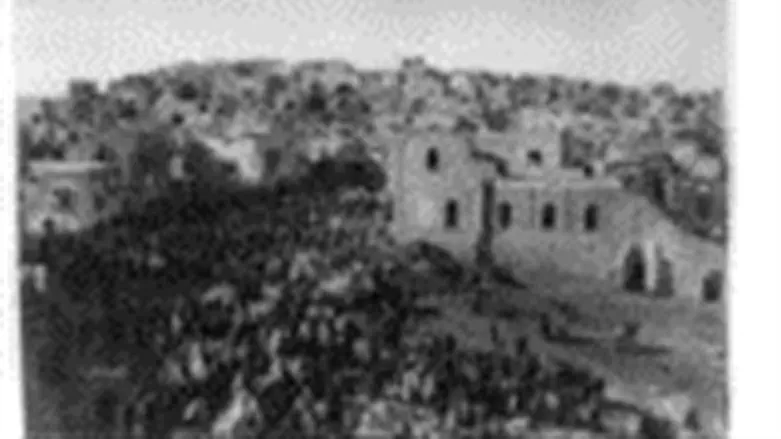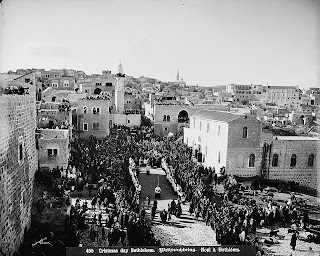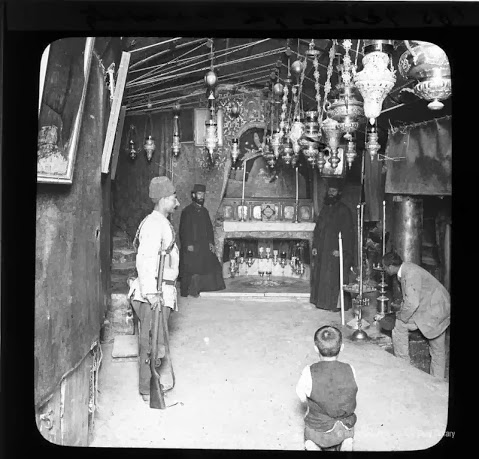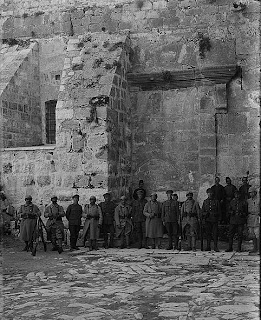
The town of Bethlehem has a history of Jewish presence and a place in Jewish history. The word "Bethlehem" is derived from the Hebrew "Beit Lechem -- House of Bread," and its fields of grain are mentioned in the Book of Ruth as where Ruth gleaned her wheat for her mother-in-law Naomi and where she met her eventual husband, Boaz.
According to the Bible, Ruth's great-grandson David was born in Bethlehem where he was anointed as king.
The town of Bethlehem also plays a major role in the Christian faith. There, Christians believe, Jesus was born some 2,000 years ago, and they celebrate his birth on Christmas.
But they don't agree on the date.
Bethlehem hosts Christmas services for Roman Catholic and Protestant denominations on December 25. This winter, Coptic, Greek and Syrian Orthodox Catholics will celebrate in the Church of the Nativity on January 7, and the Armenian Orthodox on January 6.
Entry of pilgims into Bethlehem at Christmas time (circa 1875) by photographer Félix Bonfils (Library of Congress)
Christmas procession in Bethlehem (circa 1900)
Most of the photographs on this page were taken by the American Colony Photographic Department before and after World War I when the British captured Palestine after 400 years of Ottoman rule. Other pictures are from collections at Chatham University and the Irish Catholic Church.
Church of the Nativity and Manger Square (circa 1898). Note the unfenced cemetery on the left. View here the square and cemetery approximately 20 years later, under British rule
The Church of the Nativity was built in 339 CE by King Constantine and his mother, Helena, over the grotto believed to have been the site of Jesus' birth.
Throughout history the Church was destroyed and/or rebuilt by various conquering armies -- the Samaritans, Persians, Arabs, Crusaders, Mamluks, Ottomans and British.
The Grotto beneath the Church of the Nativity in Bethlehem. The man on the right is believed to be the photographer, David Brown. Note the Turkish soldier on duty inside the Church (Credit: RCB Library, 1897).
In 1948, Bethlehem was conquered again, this time by the Jordanian Legion. Jordan ruled Bethlehem and the West Bank until 1967 when the territory was captured by Israel. In 1995, under the terms of the Oslo Accords, Israel transferred Bethlehem to the Palestinian Authority.Bethlehem was traditionally a Christian town, built around the basilica, and tourism was the most important industry. In recent years, however, the proportion of Christians in Bethlehem has dropped from 85 percent in 1948 to 54 percent in 1967, and now to about 30 percent. Some analysts point to tensions between resurgent and aggressive Islamists and the Christian community, a phenomenon pressuring other Christian communities across the Middle East, with the exception of Israel.
British and French soldiers guarding the Church of the Nativity (circa 1918)
Turkish soldiers drilling in the square outside of the Church of the Nativity in Bethlehem (circa 1900)





